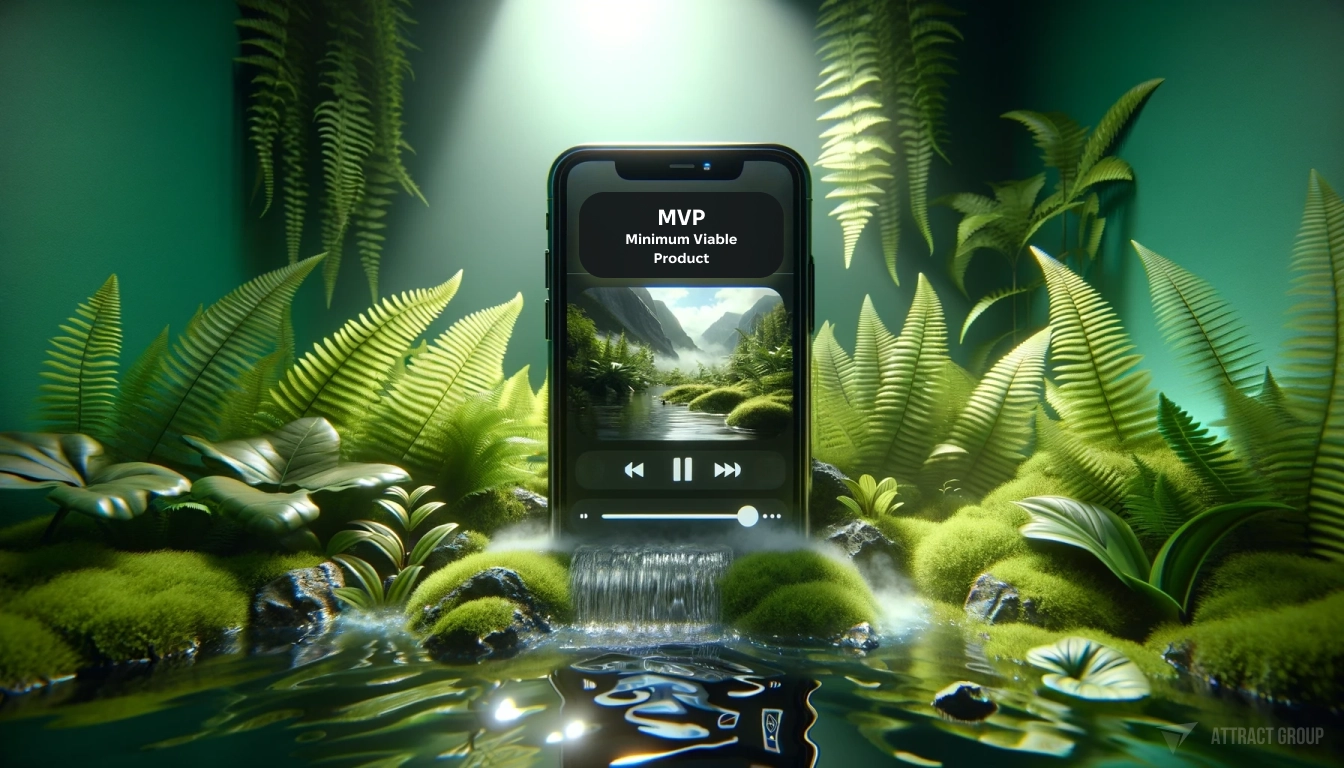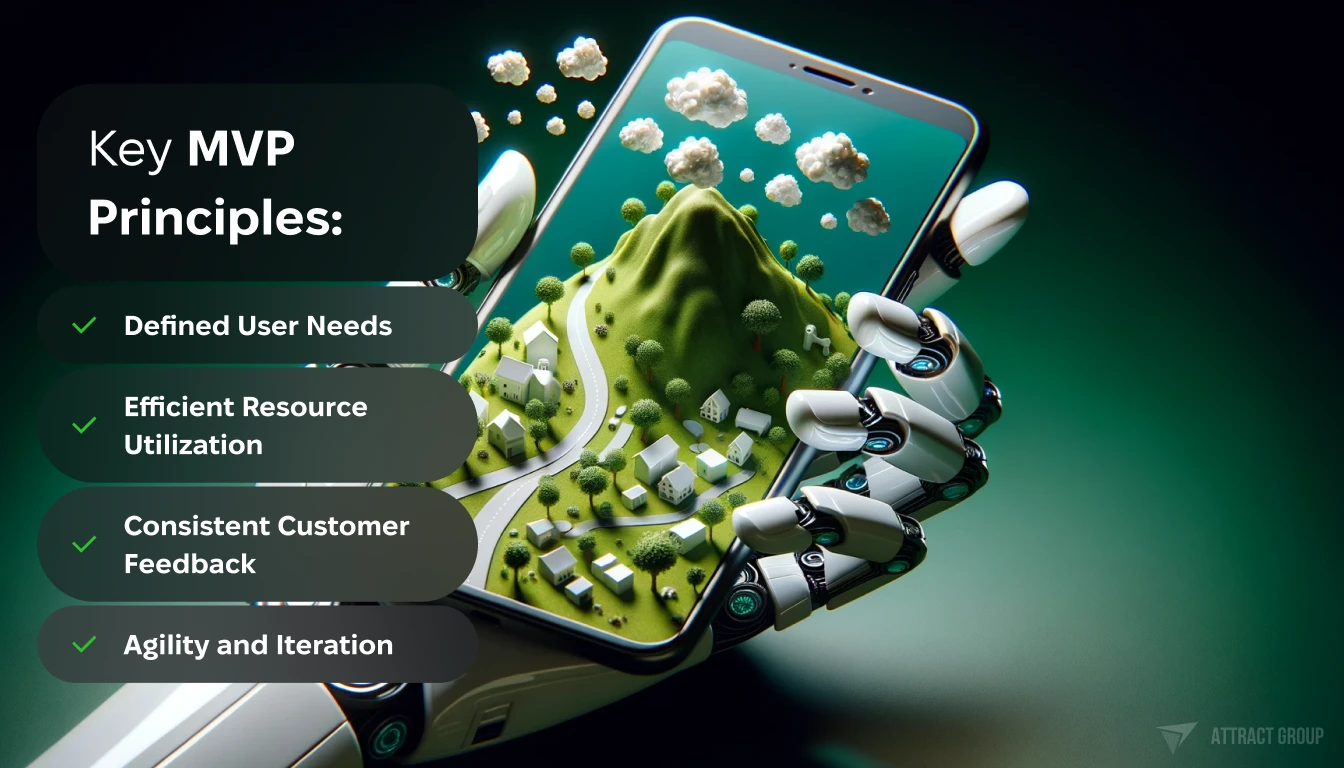What is Minimum Viable Product (MVP) and How to Shape It? Step-by-Step Guide
 4 March 2024
4 March 2024? Listen to the Summary of this article in Audio
In the realm of product development, the concept of the Minimum Viable Product — or MVP — has revolutionized the way startups and established companies bring their ideas to life. What does MVP stand for, you ask? It encapsulates the essence of innovation, where efficiency meets pragmatism in the journey from concept to market reality. At its core, it represents the most simplified version of a new product that can still be released to satisfy early adopters.
The inception story of Zappos by Nick Swinmurn in 1999 is a testament to the power of the MVP. Confronted with the need to validate the idea of selling shoes online with minimal risk, Swinmurn deployed an MVP development process that eventually grew into a billion-dollar acquisition by Amazon. MVP in product development is not just about building an MVP; it’s a strategic approach to understanding customer needs and market dynamics through hands-on learning and iterative development. As such, ‘what is an MVP’ transcends the acronym — signifying a mindset as much as a model.
The current digital ecosystem favors ventures that can pivot and adapt with speed and insight, which makes embracing the MVP framework critical. Crafting an MVP requires a balance between what the minimum encompasses and what viability means — an interplay between utility, desirability, and feasibility. Whether you’re a fledgling startup or a corporate innovator asking, “What does MVP stand for?” the answer is a blueprint for success distilled into its most essential form.

Introduction to MVP
The lexicon of modern business is rich with acronyms and slang, but few are as integral as the concept of the Minimum Viable Product. It represents the practice of introducing a new offering with enough functionality to satisfy early adopters, yet conservatively designed to maximize learning through minimal investment.
Defining MVP: What Does MVP Mean?
In pursuit of a clear MVP definition, it’s essential to grasp that the MVP acronym stands for ‘Minimum Viable Product’. This term symbolizes the foundational product that a team builds with the necessary components to serve the market and solicit user feedback. It adheres to the principle of releasing a lean version of a potential product to assess its viability in the marketplace. The MVP acronym is not just a buzzword but a strategic focus on delivering value and testing hypotheses about customer interactions with a product.
The Importance of MVP in Software Development
Understanding the significance of a minimum viable product within the domain of software development sheds light on its pivotal role. Here, the MVP explanation translates to the first step in a cycle of continuous product refinement. Software developers leverage MVP to verify product assumptions, gauge user reception, and iterate based on agile feedback mechanisms. This affords them the agility to adapt their offering to better meet user expectations without the commitment of significant resources. Knowing what does MVP mean in this context underscores its importance as a tool for software innovation and sustainable product evolution.
Our team can help you build a Minimum Viable Product to validate your concept and gather critical user feedback.
Understanding the MVP Concept
When delving into MVP in project management, many might ask, “What does MVP stand for?” MVP stands for Minimum Viable Product, but its significance extends far beyond these three words. In essence, understanding the MVP concept is critical for businesses and entrepreneurs looking to innovate and capture market opportunities effectively and efficiently.
What Does MVP Stand For?
The MVP abbreviation, a pivotal phrase in startup culture and product development, encapsulates a lean approach to creating new offerings. The MVP meaning is deeply rooted in the strategy of prioritizing quick market entry, learning from customer feedback, and making continuous product improvements. It’s about fostering innovation while managing risks, an approach that has become indispensable in the fast-paced tech industry.
Key Characteristics of an MVP
An MVP is not a haphazardly constructed prototype but rather a thoughtfully designed product version embodying essential features that address core user problems. While the term ‘minimum’ indicates simplicity, the ‘viable’ component emphasizes the product’s need to be functional and valuable from the outset. The following characteristics outline what defines a successful MVP:
- Focus on core functionalities that reflect the product’s essential value proposition.
- High usability allowing for a seamless early user adoption experience.
- Reliability to ensure that the product can be trusted to perform as designed.
- An empathetic design that shows understanding and care for the user’s needs.
- Adaptability to incorporate user insights and adapt to changing market needs efficiently.
The MVP stands for a streamlined path to greater product-market fit, providing a tangible baseline from which businesses can iterate and evolve. By adhering to these characteristics, companies can avoid overcommitting resources, minimize time to market, and maximize the learning from real-world feedback, thereby paving the way for greater innovation and success.
Steps to Shape an Effective MVP
Embarking on the journey of MVP development is a strategic endeavor that requires meticulous planning and execution. Understanding each phase of the process is essential to master how to build a minimum viable product (MVP) that meets market needs and achieves product-market fit. The foundational steps begin with distilling your idea into its purest form and validating it through consumer insights, followed by a calculated method of execution and constant refinement. Below we dissect this journey into actionable phases, supporting you in creating an MVP that aligns with your target audience’s demands and expectations.
Ideation and Market Research
At the forefront of MVP development solutions is the ideation and market research phase. Constructing a strong premise for your MVP commences with thorough market analysis, ensuring that your product not only addresses a genuine need but also has the potential to captivate the market. By engaging in comprehensive market research, insights can be gleaned to inform the overall direction of your MVP, laying the groundwork for a product closely aligned with user expectations.
Defining Core Features and User Needs
When creating an MVP, it’s paramount to distill your product to its essential features — those that provide core value to your customers and address their primary needs. This stage involves empathetic design practices and a commitment to understanding and solving real user problems, which will ultimately propel the MVP towards achieving a viable product-market fit.
Building the MVP
The construction of your MVP should balance optimal functionality with the least possible complexity. This entails a focused effort to include only the most critical features, streamlining the development process for expedience and efficacy. It’s about strategically piecing together a product that serves its intended purpose without unnecessary embellishments.

Testing and Feedback
Once your MVP reaches the testing phase, the pursuit of MVP in software development hinges on authentic user feedback. Real-world application and utilizer reviews provide priceless data, illustrating whether your product meets the needs, fulfills expectations, or requires calibration. Testing elucidates the practicality and appeal of your MVP, guiding further engineering and refinement.
Iteration and Improvement
The iterative process after deploying your MVP is imperative for continual improvement. With user feedback as a beacon, modifications and enhancements can be implemented, ensuring that successive versions of your MVP evolve more precisely to meet the market’s needs. The drive for iteration keeps your product dynamically aligned with the market, a trait essential for sustained relevance and growth.
Your MVP is a testament to your brand’s innovation, resourcefulness, and user-centric focus. Through meticulous planning and execution of these steps, you navigate your product’s journey from a nascent idea to a market-tested solution. And remember, as you learn through the MVP process, your product becomes a more refined embodiment of your vision and your users’ aspirations.
Work with our experts to plan and execute a results-driven MVP aligned with your product vision.
MVP Case Studies and Success Stories
In the rapidly evolving marketplace, MVP case studies provide invaluable insights into the successful application of the Minimum Viable Product strategy. These real-life MVP examples illustrate how startups and established entities alike have leveraged the concept of MVP in product development to validate, iterate, and thrive. Learn from the triumphs and hurdles encountered by businesses as they carved their path to success guided by the MVP philosophy.
Learning from Successful MVP Examples
Time and again, MVP success stories have underscored the potency of starting small to win big. Consider how Airbnb began by renting out air mattresses and providing breakfast in their apartment – a fundamental service that rapidly scaled into a global accommodation-sharing platform. Dropbox, too, capitalized on a simplistic MVP – a video demonstrating its file synchronization concept, which resonated with early adopters, hinting at the larger potential awaiting development. These MVP examples are exemplary for their sharp focus on core functionalities that effectively resolved user needs.
Common Mistakes and Pitfalls to Avoid
While success abounds, the MVP journey is not without its pitfalls. The path is strewn with common mistakes that can derail progress, evident through less fortunate MVP case studies. Avoiding a too-broad focus is crucial; products developed with a sweeping target audience tend to dilute the intended value. The story of Zappos, acquired by Amazon for $1.2 billion, hinged on a sharply focused MVP that confidently stepped into the online shoe sales niche. Their example is a lesson in targeting and solving precise user needs from the get-go.
| Company | MVP Focus | Key Success Factor | Outcome |
|---|---|---|---|
| Airbnb | Renting out air mattresses | Understanding the need for affordable, short-term rentals | Global accommodation-sharing platform |
| Dropbox | Video demonstration of product concept | Clear communication of product value and usability | Mass adoption and cloud storage solution leader |
| Zappos | Online shoe sales | Specific focus on solving footwear purchase convenience | Acquisition by Amazon for $1.2 billion |
To complement these case studies, businesses must recognize and sidestep pitfalls such as dismissing MVP’s ‘viable’ aspect, which may yield products that fail to meet user expectations. A rushed scaling or sidelining customer feedback can be the thin ice that breaks the stride. The narrative of the now-defunct app Color — which pushed a broad, unwieldy MVP into the market only to find disinterest — serves as a cautionary tale about the significance of viability in a product’s initial offering.
Note: Emulate these MVP success stories, but tailor your strategies to the unique nuances of your market and customer base.
Leverage our experience in MVP development to steer clear of common mistakes and maximize your probability of success.
MVP in Different Industries
Understanding the significance of Minimum Viable Product strategies in various sectors is crucial for anyone involved in product development. Whether it’s a startup aiming to disrupt the tech industry or an established entrepreneur venturing into e-commerce or mobile app development, the MVP model provides a tested approach for market entry. Let’s explore the utility and implementation of MVP across several industries, discerning how each domain harnesses its framework to optimize product launch and customer feedback integration.

MVP in Tech Startups
The MVP full form — Minimum Viable Product — finds its embodiment perfectly within the tech startup ecosystem. Here, the MVP serves as an experimental foundation to assess the feasibility of a business idea and refine the product’s core offerings. Tech startups use MVPs to learn crucial lessons about their market and customers with minimal initial expenditure, thereby reducing financial risks while validating critical business hypotheses.
MVP in E-commerce
In the digital marketplace, the role of an MVP is pivotal. The MVP explanation in e-commerce circles around testing consumer reactions to a new platform or a specific set of features, without committing to a complete market rollout. Such a strategy enables e-commerce businesses to understand consumer behavior, gauge response to product listings, and streamline the user interface, ultimately paving the way for the site’s full version launch.
MVP in Mobile App Development
When it comes to mobile app creation, the MVP holds a special place. In understanding MVP meaning in business, especially mobile-centric commerce, the emphasis falls on identifying key app features that are crucial for user satisfaction and assessing immediate value. This leads to a strategic narrowing of scope during development, focusing on the most impactful elements and using real-time user feedback to dictate the app’s future trajectory.
The version of a new product which allows a team to collect the maximum amount of validated learning about customers with the least effort. — Eric Ries
- Ability to rapidly test business models and pivot based on user feedback
- Ease of identifying the most effective market strategies earlier in the process
- Data-driven insights into customer behavior and preference trends
- Focused development on essential features, reducing unnecessary overhead
- Stepwise investment which allows for better financial planning and resource allocation
The MVP model is not just a launch strategy but a comprehensive framework for product development. Minimum Viable Product is indicative of each industry’s need to efficiently allocate scarce resources while establishing a foothold in the market. In essence, the MVP’s lean approach grants companies the flexibility to test, iterate, and evolve their offerings in response to direct consumer feedback — a strategy that remains paramount across diverse business landscapes.
The Future of MVPs
The continual evolution of MVPs reflects a paradigm shift in product development, where flexibility and speed are twin pillars of innovation. As businesses navigate the competitive terrain of the digital age, the foresight into MVP trends becomes non-negotiable. This section peeks into the crystalline ball of MVP’s prospects, spotlighting the influential currents sweeping across its landscape.
Leveraging burgeoning technologies can mitigate risks, augment learning curves, and yield products that are both nimble and impactful. A recent comprehensive study by GoodFirms on the MVP advantage provides additional insights into how these technological advancements are reshaping product development strategies. Cloud computing, AI, and analytics play critical roles in shaping MVP strategies, offering scalability without significant upfront investments.

Evolving Trends in MVP Development
Among the emerging MVP trends, meticulous emphasis on user-focused design and iterative development processes stands out. An MVP development strategy must now weave in real-time analytics and behavioral studies, ensuring product adaptations resonate deeply with user preferences. Below, we encapsulate these evolving trends in a table summarizing key factors driving the future of MVPs.
| Trend | Impact on MVP Development Strategy | Potential Benefits |
|---|---|---|
| User-Centric Design | Elevated through application of UX/UI insights catering to precise user needs and expectations. | Increased user engagement and higher adoption rates. |
| Data-Driven Iterations | Refinements rooted in quantitative and qualitative user data guide product evolution. | Validated product decisions and more focused feature enhancements. |
| Rapid Prototyping & Testing | Accelerated feedback loops enabled by swift prototype deployment. | Quicker time-to-market and agility in addressing market needs. |
| Leveraging AI & Machine Learning | Integrating predictive analytics to gauge future user behavior and preemptively shape MVP features. | Proactive adaptation to market dynamics and user trends. |
These trends not only inform MVP development strategy but also impel the refinement of lean methodologies, propelling MVPs to become more than bare-bone products. As the future unfolds, MVPs are expected to integrate greater user insights, embody more comprehensive iteration cycles, and espouse impactful, data-backed decisions.
How Technology is Shaping MVP Strategies
In the sphere of software innovation, MVP in software development is undergoing transformation through technological advancements. Leveraging burgeoning technologies can mitigate risks, augment learning curves, and yield products that are both nimble and impactful. Cloud computing, AI, and analytics play critical roles in shaping MVP strategies, offering scalability without significant upfront investments. They allow MVPs to transcend traditional barriers and embrace a level of sophistication previously unattainable at initial development stages.
- Cloud services reduce operational costs and allow real-time scaling and updates.
- Artificial Intelligence contributes to smarter MVPs with predictive capabilities and personalized experiences.
- Advanced analytics offer in-depth user behavior insights, paving the way for sharper MVP refinements.
The interplay between these technological forces and MVP development heralds a bright future — one where MVPs are more connected, aligned, and attuned to the ever-evolving needs of the digital marketplace. By harnessing these technologies, businesses can ensure that their MVPs are not merely viable but are veritable launchpads to sustained success and innovation in the long run.
Maximizing Success with MVP
The journey of MVP in product development is much more than building an MVP; it’s a vibrant cycle of innovation, validation, and iteration. The ultimate aim is to chalk out the trajectory of success with MVP — each step delicately woven into the product’s lifecycle, affirming MVP importance at every stage. Beginning with a strategically humble yet functionally coherent version of the product, a successful MVP serves as a launch pad for a business idea, providing substantial learning with minimal risk.
For businesses, the linchpin of attaining success with an MVP hinges on their ability to align development processes with in-depth user insights and business strategy. An MVP thrives on feedback — embracing a culture where customer responses are not just heard but are intricately analyzed and applied towards enhancing the product offering. This process of building, measuring, and learning creates a robust feedback loop that ensures the MVP stays relevant and resonant with the user base.
| Key MVP Principles | Role in Product Development | Impact on Business Success |
|---|---|---|
| Defined User Needs | Ensures that MVP features align with user requirements for solving specific problems. | Higher user satisfaction and increased chance of early adoption. |
| Efficient Resource Utilization | Minimizes wastage and focuses investment on core product capabilities. | Cost-effective development and clear focus on value generation. |
| Consistent Customer Feedback | Facilitates iterative refinements and adherence to user-centric models. | A product that is continually improved according to market needs. |
| Agility and Iteration | Allows for quick response to market feedback and adaptive product evolution. | Keeps the product competitive and aligned with dynamic market trends. |
The emphasis on building an MVP is vital — as it epitomizes the commitment to deliver a product that may start small but is poised for growth. ‘Viable’ in the MVP context is not just about meeting the bare minimum requirements; it’s about setting a foundation for excellence and scalability. The business landscape is strewn with stories of swift adaptations, driven by innovative MVPs, that have catapulted simple ideas into mainstream solutions.
- Lean and purposeful feature set to address critical customer needs
- Meticulous market-fit analysis and prompt strategic pivoting
- Clear and actionable user engagement data to steer product direction
- Resourceful approach that turns constraints into creative problem-solving
The application of these principles propels businesses and entrepreneurs to not just ride the wave of MVP in product development but to command its direction. It’s this control, combined with the dexterity to navigate the market, that marks the true success of an MVP — and by extension, the product it represents.

Our specialists stay ahead of MVP trends and can help you optimize your approach for long-term viability.
Common Questions About MVPs
In the universe of product development, deciphering the acronym MVP is fundamental to understanding its impact on the process. The term MVP stands for Minimum Viable Product and serves as a strategic method for validating a business concept. For those pondering over ‘what does MVP mean’, it signifies a version of a product with just enough features to engage early adopters and provide a testing ground for market viability. Such an approach enables teams to sidestep large-scale risks while focusing on core functionalities that meet user needs.
The difference between MVP and similar concepts like proof of concept (PoC) or prototypes often leaves room for confusion. A PoC is typically developed to demonstrate the feasibility or practical potential of a concept, whereas a prototype is a preliminary model to explore the look and functionality of a product. In contrast, an MVP is rolled out to actual users to gather qualitative feedback and gauge the product’s future prospects in the market. The MVP meaning essentially hinges on learning from real-world use, a practice that moves beyond the theoretical and into the domain of practiced application.
With a firm grasp of the mvp full form and its practical implications, building an MVP translates to constructing a minimal but functioning model of your product worthy of customer interaction. The MVP explanation underlines the build-measure-learn framework, which promotes an iterative development process based on user insights and gradual enhancements. Understanding ‘what is MVP’ in this capacity guides stakeholders on how to craft a product that not only resonates with its target audience from the outset but also forms a solid foundation for future iterations and improvements.
FAQs
What Does MVP Mean?
MVP stands for Minimum Viable Product. It is a strategy used in product development in which a new product is developed with sufficient features to satisfy early adopters. The final, complete set of features is only designed and developed after considering feedback from the product’s initial users.
The Importance of MVP in Software Development
In software development, the MVP allows teams to gather user feedback as quickly as possible to iterate and improve the product. By focusing on the core functionalities that provide the most value to users, developers can validate ideas early in the product lifecycle, reduce time to market, and avoid extensive upfront costs.
What Does MVP Stand For?
MVP stands for Minimum Viable Product. It refers to a development technique in which a new product or website is introduced in the market with basic features, but enough to get the attention of the consumers. The idea is to validate the product idea early in the development cycle.
Key Characteristics of an MVP
An MVP includes only the core features that allow the project to be deployed and no more. The product is typically deployed to a subset of possible customers to gauge the product’s efficacy and to guide further development. Characteristics of an MVP include minimalism, focus on the core value proposition, usability, reliability, and ease of iteration.
Ideation and Market Research
This step involves brainstorming ideas and conducting research to understand market needs. It’s crucial to validate that the product concept addresses real problems for real users to ensure that the MVP will be relevant upon release.
Defining Core Features and User Needs
Based on market research, identify the core features that your MVP will need to solve your users’ problems. This should also involve creating user personas to understand who the product is for and what these users value the most.
Building the MVP
With core features identified, the next step is to build out the MVP. This version should focus on core functionality to meet user needs with minimum but complete features that allow the product to be used as intended.
Testing and Feedback
After launch, the MVP should be rigorously tested by real users. The feedback collected from this stage is invaluable, as it will inform what is working, what’s not, and what can be improved for future iterations.
Iteration and Improvement
Utilizing the feedback gathered, the product team should make the necessary improvements. This process of iteration can involve adding new features, removing or tweaking existing ones, or even pivoting the product direction entirely if necessary.
Learning from Successful MVP Examples
Studying successful MVPs can provide insights into effective strategies and best practices. Companies like Zappos and Dropbox used MVPs to validate their business models effectively, which helped them scale rapidly after confirming product-market fit.
Common Mistakes and Pitfalls to Avoid
A common mistake in creating an MVP is overlooking the viability aspect, which can result in a product that is incomplete or unappealing to users. Other pitfalls include overcomplicating the MVP with unnecessary features or not properly analyzing user feedback.
How Technology is Shaping MVP Strategies?
Technological advancements like AI and machine learning are influencing MVP development by enabling more sophisticated testing and learning mechanisms. This results in products that are more closely aligned with user needs and market demand.
How does an MVP differ from a prototype?
An MVP is a minimalist version of a product that is ready for market release and can provide immediate value to users, while a prototype is often a preliminary model used to visualize or test concepts before an MVP is developed.
Why is an MVP important in software development?
An MVP is important in software development because it enables developers to validate product and market fit quickly, test out ideas with real users, and iterate effectively based on precise feedback, thereby minimizing risk and initial investment.










